2005 MERCEDES-BENZ SPRINTER heating
[x] Cancel search: heatingPage 1196 of 1232

(7) Connect the wire harness connector to the
heater water valve.
(8) Reconnect the battery negative cable.
(9) Fill the cooling system (Refer to 7 - COOLING/
ENGINE/COOLANT - STANDARD PROCEDURE).
UNDERBODY LINES
REMOVAL
The rear refrigerant lines for the optional rear A/C
system is serviced in four sections. The liquid line for
the optional rear A/C system uses a spring-lock
refrigerant line coupler which requires the use of a
3/8 inch quick-disconnect tool (part of Special Tool,
A/C Line Disconnect Kit 7193).
WARNING: REVIEW THE WARNINGS AND CAU-
TIONS IN THE FRONT OF THIS SECTION BEFORE
PERFORMING THE FOLLOWING OPERATION (Refer
to 24 - HEATING & AIR CONDITIONING/PLUMBING -
WARNING) and (Refer to 24 - HEATING & AIR CON-
DITIONING/PLUMBING - CAUTION).
FRONT LIQUID LINE
(1) Recover the refrigerant from the refrigerant
system (Refer to 24 - HEATING & AIR CONDITION-
ING/PLUMBING - STANDARD PROCEDURE).
(2) Disconnect and isolate the battery negative
cable.
(3) Disconnect the rear section of the front liquid
line from the receiver-drier and the evaporator (Refer
to 24 - HEATING & AIR CONDITIONING/PLUMB-
ING/LIQUID LINE - REMOVAL).
(4) Disconnect the fitting to the intermediate liq-
uid line using Special Tool, A/C Line Disconnect Kit
7193.
(5) Remove the seals from the liquid line fittings
and discard.
(6) Install plug in, or tape over the open liquid line
fittings, the reciever-drier outlet port and the expan-
sion valve ports.
(7) Remove the front liquid line from the engine
compartment.
FRONT SUCTION LINE
(1) Recover the refrigerant from the refrigerant
system (Refer to 24 - HEATING & AIR CONDITION-
ING/PLUMBING - STANDARD PROCEDURE).
(2) Disconnect and isolate the battery negative
cable.
(3) Remove the nut that secures the intermediate
suction line fitting to the stud on the front suction
line tapping plate.
(4) Disconnect the intermediate suction line fitting
from the front suction line tapping plate.(5) Install plug in, or tape over the open suction
line fitting and the front suction line tapping plate
inlet port.
(6) Disconnect the front suction line from the com-
pressor and front evaporator valve (Refer to 24 -
HEATING & AIR CONDITIONING/PLUMBING/
SUCTION LINE - REMOVAL).
(7) Remove the seals from the open suction line fit-
tings and discard.
(8) Install plug in, or tape over the open suction
line fittings, the compressor inlet port and the expan-
sion valve ports.
(9) Remove the front suction line from the engine
compartment.
(10) If necessary, remove the bolt that secures the
compressor portion of the front suction line to the
front suction line tapping plate, separate the front
suction lines, remove and discard the seal and, plug
in, or tape over the open suction line fittings.
INTERMEDIATE REFRIGERANT LINES
(1) Recover the refrigerant from the refrigerant
system (Refer to 24 - HEATING & AIR CONDITION-
ING/PLUMBING/REFRIGERANT - STANDARD
PROCEDURE).
(2) Disconnect and isolate the battery negative
cable.
(3) Disconnect the intermediate liquid line from
the front liquid line using Special Tool, A/C Line Dis-
connect Kit 7193.
(4) Remove the nut that secures the intermediate
suction line fitting to the stud on the front suction
line tapping plate.
(5) Disconnect the intermediate suction line from
the front suction line tapping plate.
(6) Remove the seals from the liquid and suction
line fittings and discard.
(7) Install plug in, or tape over the open suction
and liquid line fittings and the front suction line tap-
ping plate inlet port.
(8) Raise and support the vehicle.
(9) Disconnect the fittings that secure the interme-
diate refrigerant lines to the rear refrigerant lines.
(10) Remove the seals from the open liquid and
suction line fittings and discard.
(11) Install plugs in, or tape over the open liquid
and suction line fittings.
(12) Remove the bolts that secure the two interme-
diate refrigerant line retaining blocks to the vehicle
underbody.
(13) Remove the intermediate section of the rear
refrigerant lines from the vehicle underbody.
REAR REFRIGERANT LINES
(1) Recover the refrigerant from the refrigerant
system (Refer to 24 - HEATING & AIR CONDITION-
24 - 68 PLUMBINGVA
WATER VALVE (Continued)
Page 1197 of 1232
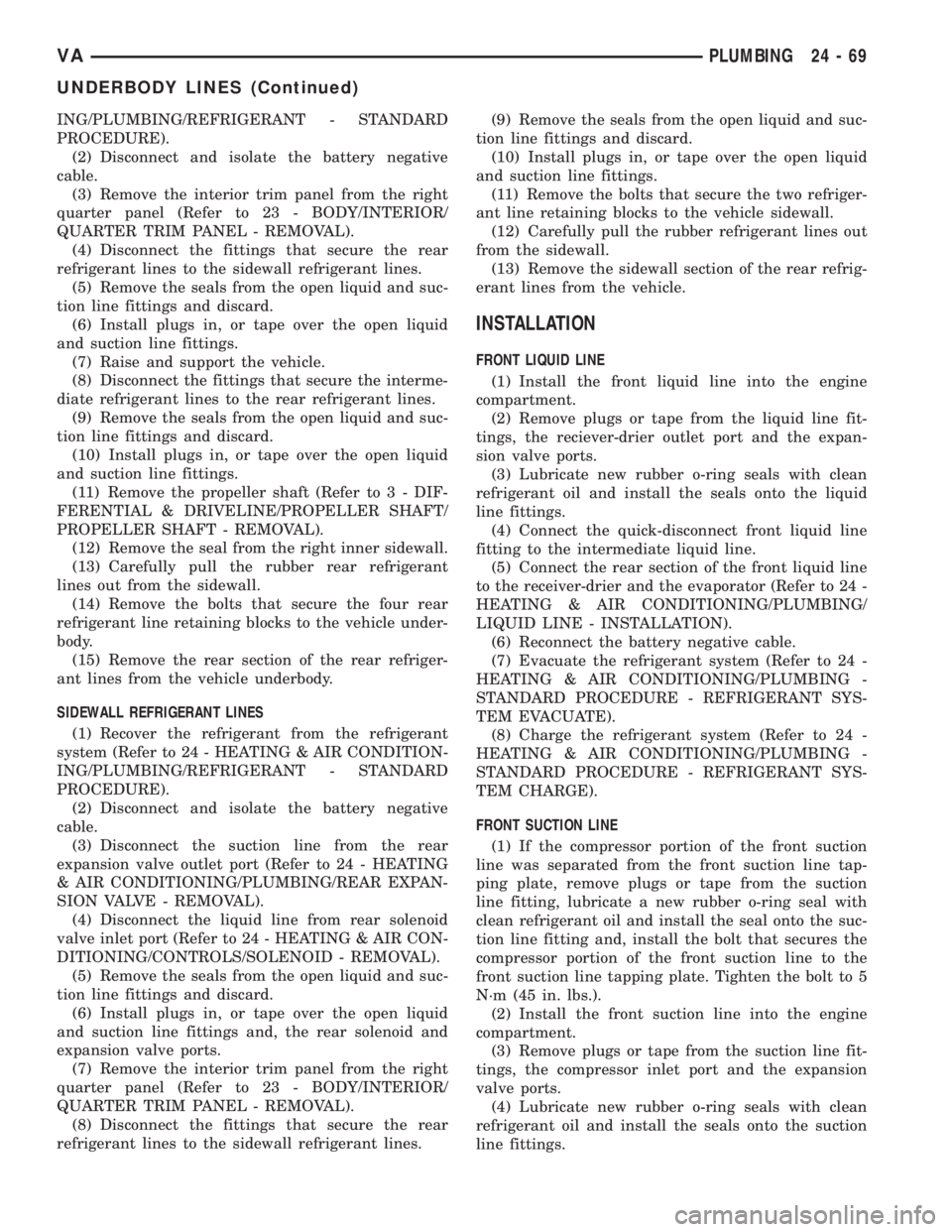
ING/PLUMBING/REFRIGERANT - STANDARD
PROCEDURE).
(2) Disconnect and isolate the battery negative
cable.
(3) Remove the interior trim panel from the right
quarter panel (Refer to 23 - BODY/INTERIOR/
QUARTER TRIM PANEL - REMOVAL).
(4) Disconnect the fittings that secure the rear
refrigerant lines to the sidewall refrigerant lines.
(5) Remove the seals from the open liquid and suc-
tion line fittings and discard.
(6) Install plugs in, or tape over the open liquid
and suction line fittings.
(7) Raise and support the vehicle.
(8) Disconnect the fittings that secure the interme-
diate refrigerant lines to the rear refrigerant lines.
(9) Remove the seals from the open liquid and suc-
tion line fittings and discard.
(10) Install plugs in, or tape over the open liquid
and suction line fittings.
(11) Remove the propeller shaft (Refer to 3 - DIF-
FERENTIAL & DRIVELINE/PROPELLER SHAFT/
PROPELLER SHAFT - REMOVAL).
(12) Remove the seal from the right inner sidewall.
(13) Carefully pull the rubber rear refrigerant
lines out from the sidewall.
(14) Remove the bolts that secure the four rear
refrigerant line retaining blocks to the vehicle under-
body.
(15) Remove the rear section of the rear refriger-
ant lines from the vehicle underbody.
SIDEWALL REFRIGERANT LINES
(1) Recover the refrigerant from the refrigerant
system (Refer to 24 - HEATING & AIR CONDITION-
ING/PLUMBING/REFRIGERANT - STANDARD
PROCEDURE).
(2) Disconnect and isolate the battery negative
cable.
(3) Disconnect the suction line from the rear
expansion valve outlet port (Refer to 24 - HEATING
& AIR CONDITIONING/PLUMBING/REAR EXPAN-
SION VALVE - REMOVAL).
(4) Disconnect the liquid line from rear solenoid
valve inlet port (Refer to 24 - HEATING & AIR CON-
DITIONING/CONTROLS/SOLENOID - REMOVAL).
(5) Remove the seals from the open liquid and suc-
tion line fittings and discard.
(6) Install plugs in, or tape over the open liquid
and suction line fittings and, the rear solenoid and
expansion valve ports.
(7) Remove the interior trim panel from the right
quarter panel (Refer to 23 - BODY/INTERIOR/
QUARTER TRIM PANEL - REMOVAL).
(8) Disconnect the fittings that secure the rear
refrigerant lines to the sidewall refrigerant lines.(9) Remove the seals from the open liquid and suc-
tion line fittings and discard.
(10) Install plugs in, or tape over the open liquid
and suction line fittings.
(11) Remove the bolts that secure the two refriger-
ant line retaining blocks to the vehicle sidewall.
(12) Carefully pull the rubber refrigerant lines out
from the sidewall.
(13) Remove the sidewall section of the rear refrig-
erant lines from the vehicle.
INSTALLATION
FRONT LIQUID LINE
(1) Install the front liquid line into the engine
compartment.
(2) Remove plugs or tape from the liquid line fit-
tings, the reciever-drier outlet port and the expan-
sion valve ports.
(3) Lubricate new rubber o-ring seals with clean
refrigerant oil and install the seals onto the liquid
line fittings.
(4) Connect the quick-disconnect front liquid line
fitting to the intermediate liquid line.
(5) Connect the rear section of the front liquid line
to the receiver-drier and the evaporator (Refer to 24 -
HEATING & AIR CONDITIONING/PLUMBING/
LIQUID LINE - INSTALLATION).
(6) Reconnect the battery negative cable.
(7) Evacuate the refrigerant system (Refer to 24 -
HEATING & AIR CONDITIONING/PLUMBING -
STANDARD PROCEDURE - REFRIGERANT SYS-
TEM EVACUATE).
(8) Charge the refrigerant system (Refer to 24 -
HEATING & AIR CONDITIONING/PLUMBING -
STANDARD PROCEDURE - REFRIGERANT SYS-
TEM CHARGE).
FRONT SUCTION LINE
(1) If the compressor portion of the front suction
line was separated from the front suction line tap-
ping plate, remove plugs or tape from the suction
line fitting, lubricate a new rubber o-ring seal with
clean refrigerant oil and install the seal onto the suc-
tion line fitting and, install the bolt that secures the
compressor portion of the front suction line to the
front suction line tapping plate. Tighten the bolt to 5
N´m (45 in. lbs.).
(2) Install the front suction line into the engine
compartment.
(3) Remove plugs or tape from the suction line fit-
tings, the compressor inlet port and the expansion
valve ports.
(4) Lubricate new rubber o-ring seals with clean
refrigerant oil and install the seals onto the suction
line fittings.
VAPLUMBING 24 - 69
UNDERBODY LINES (Continued)
Page 1198 of 1232
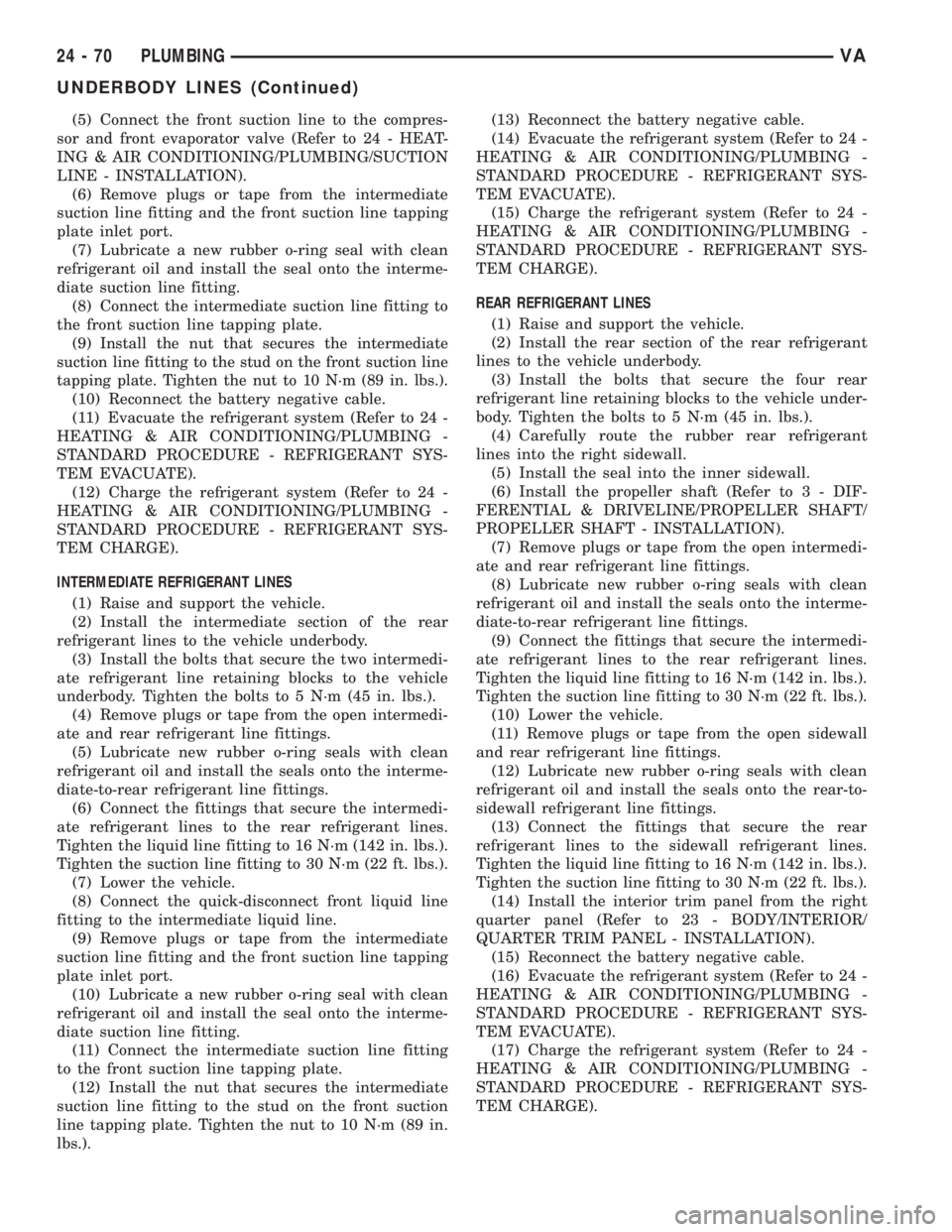
(5) Connect the front suction line to the compres-
sor and front evaporator valve (Refer to 24 - HEAT-
ING & AIR CONDITIONING/PLUMBING/SUCTION
LINE - INSTALLATION).
(6) Remove plugs or tape from the intermediate
suction line fitting and the front suction line tapping
plate inlet port.
(7) Lubricate a new rubber o-ring seal with clean
refrigerant oil and install the seal onto the interme-
diate suction line fitting.
(8) Connect the intermediate suction line fitting to
the front suction line tapping plate.
(9)
Install the nut that secures the intermediate
suction line fitting to the stud on the front suction line
tapping plate. Tighten the nut to 10 N´m (89 in. lbs.).
(10) Reconnect the battery negative cable.
(11) Evacuate the refrigerant system (Refer to 24 -
HEATING & AIR CONDITIONING/PLUMBING -
STANDARD PROCEDURE - REFRIGERANT SYS-
TEM EVACUATE).
(12) Charge the refrigerant system (Refer to 24 -
HEATING & AIR CONDITIONING/PLUMBING -
STANDARD PROCEDURE - REFRIGERANT SYS-
TEM CHARGE).
INTERMEDIATE REFRIGERANT LINES
(1) Raise and support the vehicle.
(2) Install the intermediate section of the rear
refrigerant lines to the vehicle underbody.
(3) Install the bolts that secure the two intermedi-
ate refrigerant line retaining blocks to the vehicle
underbody. Tighten the bolts to 5 N´m (45 in. lbs.).
(4) Remove plugs or tape from the open intermedi-
ate and rear refrigerant line fittings.
(5) Lubricate new rubber o-ring seals with clean
refrigerant oil and install the seals onto the interme-
diate-to-rear refrigerant line fittings.
(6) Connect the fittings that secure the intermedi-
ate refrigerant lines to the rear refrigerant lines.
Tighten the liquid line fitting to 16 N´m (142 in. lbs.).
Tighten the suction line fitting to 30 N´m (22 ft. lbs.).
(7) Lower the vehicle.
(8) Connect the quick-disconnect front liquid line
fitting to the intermediate liquid line.
(9) Remove plugs or tape from the intermediate
suction line fitting and the front suction line tapping
plate inlet port.
(10) Lubricate a new rubber o-ring seal with clean
refrigerant oil and install the seal onto the interme-
diate suction line fitting.
(11) Connect the intermediate suction line fitting
to the front suction line tapping plate.
(12) Install the nut that secures the intermediate
suction line fitting to the stud on the front suction
line tapping plate. Tighten the nut to 10 N´m (89 in.
lbs.).(13) Reconnect the battery negative cable.
(14) Evacuate the refrigerant system (Refer to 24 -
HEATING & AIR CONDITIONING/PLUMBING -
STANDARD PROCEDURE - REFRIGERANT SYS-
TEM EVACUATE).
(15) Charge the refrigerant system (Refer to 24 -
HEATING & AIR CONDITIONING/PLUMBING -
STANDARD PROCEDURE - REFRIGERANT SYS-
TEM CHARGE).
REAR REFRIGERANT LINES
(1) Raise and support the vehicle.
(2) Install the rear section of the rear refrigerant
lines to the vehicle underbody.
(3) Install the bolts that secure the four rear
refrigerant line retaining blocks to the vehicle under-
body. Tighten the bolts to 5 N´m (45 in. lbs.).
(4) Carefully route the rubber rear refrigerant
lines into the right sidewall.
(5) Install the seal into the inner sidewall.
(6) Install the propeller shaft (Refer to 3 - DIF-
FERENTIAL & DRIVELINE/PROPELLER SHAFT/
PROPELLER SHAFT - INSTALLATION).
(7) Remove plugs or tape from the open intermedi-
ate and rear refrigerant line fittings.
(8) Lubricate new rubber o-ring seals with clean
refrigerant oil and install the seals onto the interme-
diate-to-rear refrigerant line fittings.
(9) Connect the fittings that secure the intermedi-
ate refrigerant lines to the rear refrigerant lines.
Tighten the liquid line fitting to 16 N´m (142 in. lbs.).
Tighten the suction line fitting to 30 N´m (22 ft. lbs.).
(10) Lower the vehicle.
(11) Remove plugs or tape from the open sidewall
and rear refrigerant line fittings.
(12) Lubricate new rubber o-ring seals with clean
refrigerant oil and install the seals onto the rear-to-
sidewall refrigerant line fittings.
(13) Connect the fittings that secure the rear
refrigerant lines to the sidewall refrigerant lines.
Tighten the liquid line fitting to 16 N´m (142 in. lbs.).
Tighten the suction line fitting to 30 N´m (22 ft. lbs.).
(14) Install the interior trim panel from the right
quarter panel (Refer to 23 - BODY/INTERIOR/
QUARTER TRIM PANEL - INSTALLATION).
(15) Reconnect the battery negative cable.
(16) Evacuate the refrigerant system (Refer to 24 -
HEATING & AIR CONDITIONING/PLUMBING -
STANDARD PROCEDURE - REFRIGERANT SYS-
TEM EVACUATE).
(17) Charge the refrigerant system (Refer to 24 -
HEATING & AIR CONDITIONING/PLUMBING -
STANDARD PROCEDURE - REFRIGERANT SYS-
TEM CHARGE).
24 - 70 PLUMBINGVA
UNDERBODY LINES (Continued)
Page 1199 of 1232

SIDEWALL REFRIGERANT LINES
(1) Install the sidewall section of the rear refriger-
ant lines to the vehicle.
(2) Carefully route the rubber refrigerant lines
through the sidewall.
(3) Install the bolts that secure the two refrigerant
line retaining blocks to the vehicle sidewall. Tighten
the bolts to 5 N´m (45 in. lbs.).
(4) Remove plugs or tape from the open rear and
sidewall refrigerant line fittings.
(5) Lubricate new rubber o-ring seals with clean
refrigerant oil and install the seals onto the rear-to-
sidewall refrigerant line fittings.
(6) Connect the fittings that secure the rear refrig-
erant lines to the sidewall refrigerant lines. Tighten
the liquid line fitting to 16 N´m (142 in. lbs.). Tighten
the suction line fitting to 30 N´m (22 ft. lbs.).
(7) Install the interior trim panel from the right
quarter panel (Refer to 23 - BODY/INTERIOR/
QUARTER TRIM PANEL - INSTALLATION).
(8) Remove plugs or tape from the open sidewall
liquid and suction line fittings and, the rear solenoid
and expansion valve ports.(9) Lubricate new rubber o-ring seals with clean
refrigerant oil and install the seals onto the sidewall
refrigerant line fittings.
(10) Connect the liquid line to the rear solenoid
valve inlet port (Refer to 24 - HEATING & AIR CON-
DITIONING/CONTROLS/SOLENOID - INSTALLA-
TION).
(11) Connect the suction line to the rear expansion
valve outlet port and reinstall the rear A/C evapora-
tor panel and duct (Refer to 24 - HEATING & AIR
CONDITIONING/PLUMBING/REAR EXPANSION
VALVE - INSTALLATION).
(12) Connect the battery negative cable.
(13) Evacuate the refrigerant system (Refer to 24 -
HEATING & AIR CONDITIONING/PLUMBING -
STANDARD PROCEDURE - REFRIGERANT SYS-
TEM EVACUATE).
(14) Charge the refrigerant system (Refer to 24 -
HEATING & AIR CONDITIONING/PLUMBING -
STANDARD PROCEDURE - REFRIGERANT SYS-
TEM CHARGE).
VAPLUMBING 24 - 71
UNDERBODY LINES (Continued)
Page 1202 of 1232
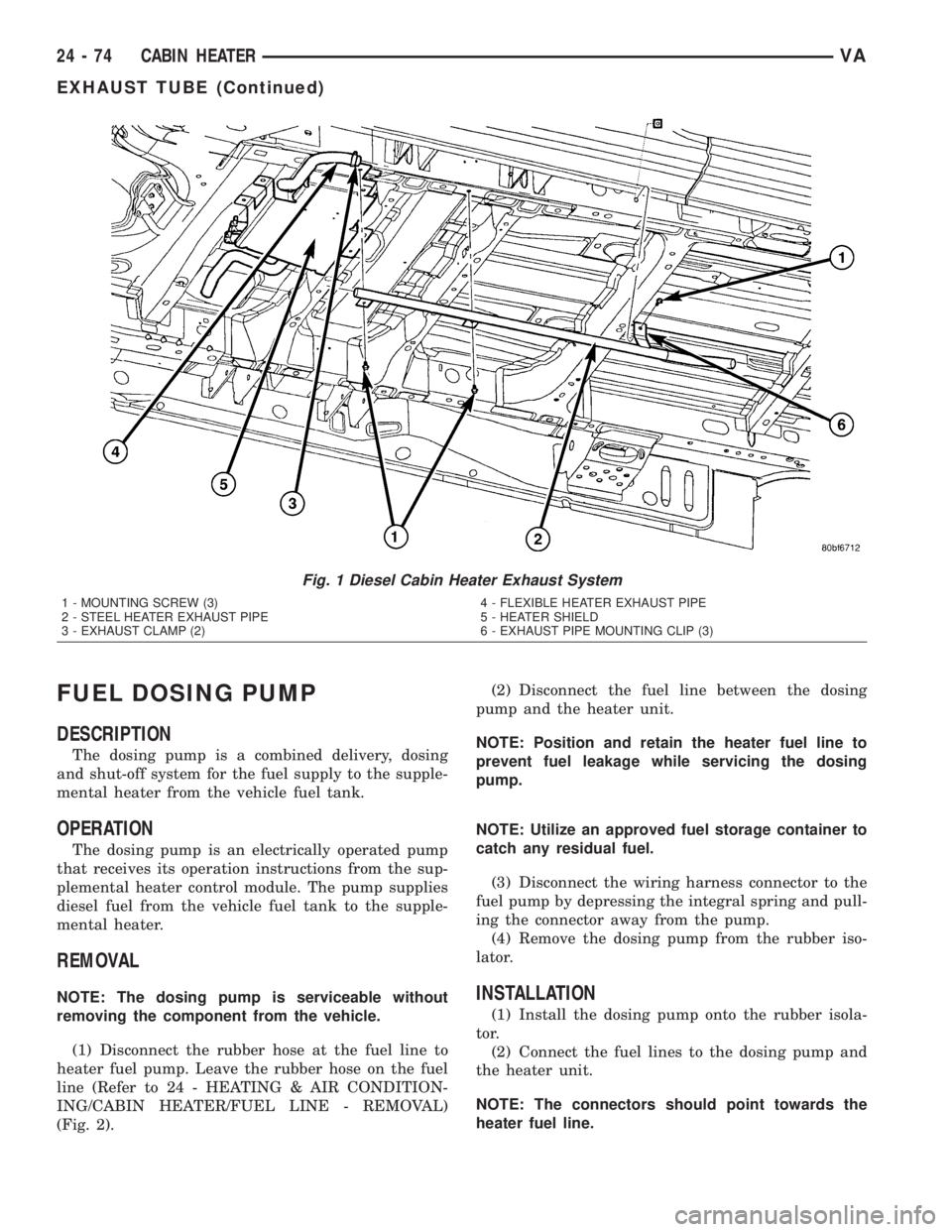
FUEL DOSING PUMP
DESCRIPTION
The dosing pump is a combined delivery, dosing
and shut-off system for the fuel supply to the supple-
mental heater from the vehicle fuel tank.
OPERATION
The dosing pump is an electrically operated pump
that receives its operation instructions from the sup-
plemental heater control module. The pump supplies
diesel fuel from the vehicle fuel tank to the supple-
mental heater.
REMOVAL
NOTE: The dosing pump is serviceable without
removing the component from the vehicle.
(1) Disconnect the rubber hose at the fuel line to
heater fuel pump. Leave the rubber hose on the fuel
line (Refer to 24 - HEATING & AIR CONDITION-
ING/CABIN HEATER/FUEL LINE - REMOVAL)
(Fig. 2).(2) Disconnect the fuel line between the dosing
pump and the heater unit.
NOTE: Position and retain the heater fuel line to
prevent fuel leakage while servicing the dosing
pump.
NOTE: Utilize an approved fuel storage container to
catch any residual fuel.
(3) Disconnect the wiring harness connector to the
fuel pump by depressing the integral spring and pull-
ing the connector away from the pump.
(4) Remove the dosing pump from the rubber iso-
lator.INSTALLATION
(1) Install the dosing pump onto the rubber isola-
tor.
(2) Connect the fuel lines to the dosing pump and
the heater unit.
NOTE: The connectors should point towards the
heater fuel line.
Fig. 1 Diesel Cabin Heater Exhaust System
1 - MOUNTING SCREW (3)
2 - STEEL HEATER EXHAUST PIPE
3 - EXHAUST CLAMP (2)4 - FLEXIBLE HEATER EXHAUST PIPE
5 - HEATER SHIELD
6 - EXHAUST PIPE MOUNTING CLIP (3)
24 - 74 CABIN HEATERVA
EXHAUST TUBE (Continued)
Page 1203 of 1232
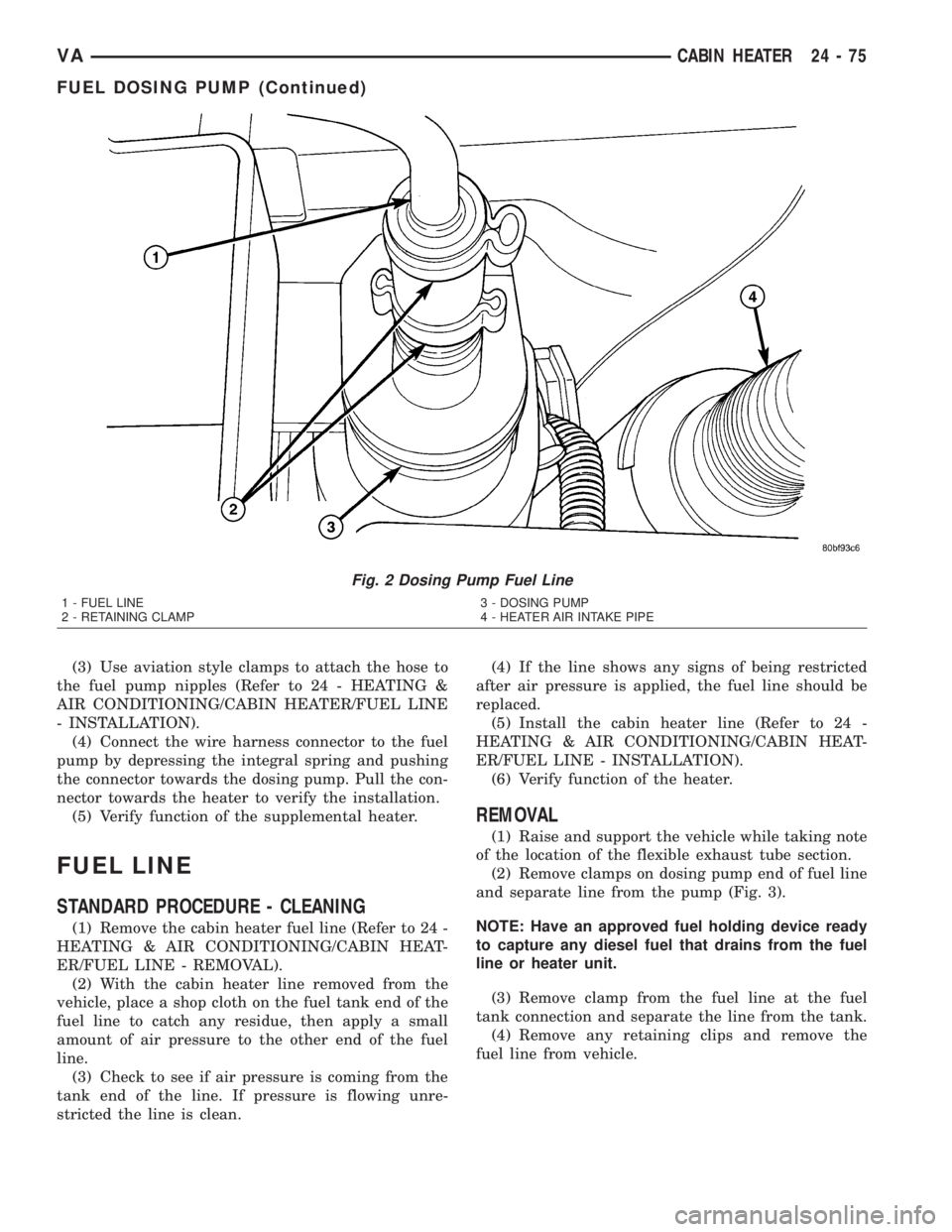
(3) Use aviation style clamps to attach the hose to
the fuel pump nipples (Refer to 24 - HEATING &
AIR CONDITIONING/CABIN HEATER/FUEL LINE
- INSTALLATION).
(4) Connect the wire harness connector to the fuel
pump by depressing the integral spring and pushing
the connector towards the dosing pump. Pull the con-
nector towards the heater to verify the installation.
(5) Verify function of the supplemental heater.
FUEL LINE
STANDARD PROCEDURE - CLEANING
(1) Remove the cabin heater fuel line (Refer to 24 -
HEATING & AIR CONDITIONING/CABIN HEAT-
ER/FUEL LINE - REMOVAL).
(2) With the cabin heater line removed from the
vehicle, place a shop cloth on the fuel tank end of the
fuel line to catch any residue, then apply a small
amount of air pressure to the other end of the fuel
line.
(3) Check to see if air pressure is coming from the
tank end of the line. If pressure is flowing unre-
stricted the line is clean.(4) If the line shows any signs of being restricted
after air pressure is applied, the fuel line should be
replaced.
(5) Install the cabin heater line (Refer to 24 -
HEATING & AIR CONDITIONING/CABIN HEAT-
ER/FUEL LINE - INSTALLATION).
(6) Verify function of the heater.
REMOVAL
(1) Raise and support the vehicle while taking note
of the location of the flexible exhaust tube section.
(2) Remove clamps on dosing pump end of fuel line
and separate line from the pump (Fig. 3).
NOTE: Have an approved fuel holding device ready
to capture any diesel fuel that drains from the fuel
line or heater unit.
(3) Remove clamp from the fuel line at the fuel
tank connection and separate the line from the tank.
(4) Remove any retaining clips and remove the
fuel line from vehicle.
Fig. 2 Dosing Pump Fuel Line
1 - FUEL LINE
2 - RETAINING CLAMP3 - DOSING PUMP
4 - HEATER AIR INTAKE PIPE
VACABIN HEATER 24 - 75
FUEL DOSING PUMP (Continued)
Page 1205 of 1232
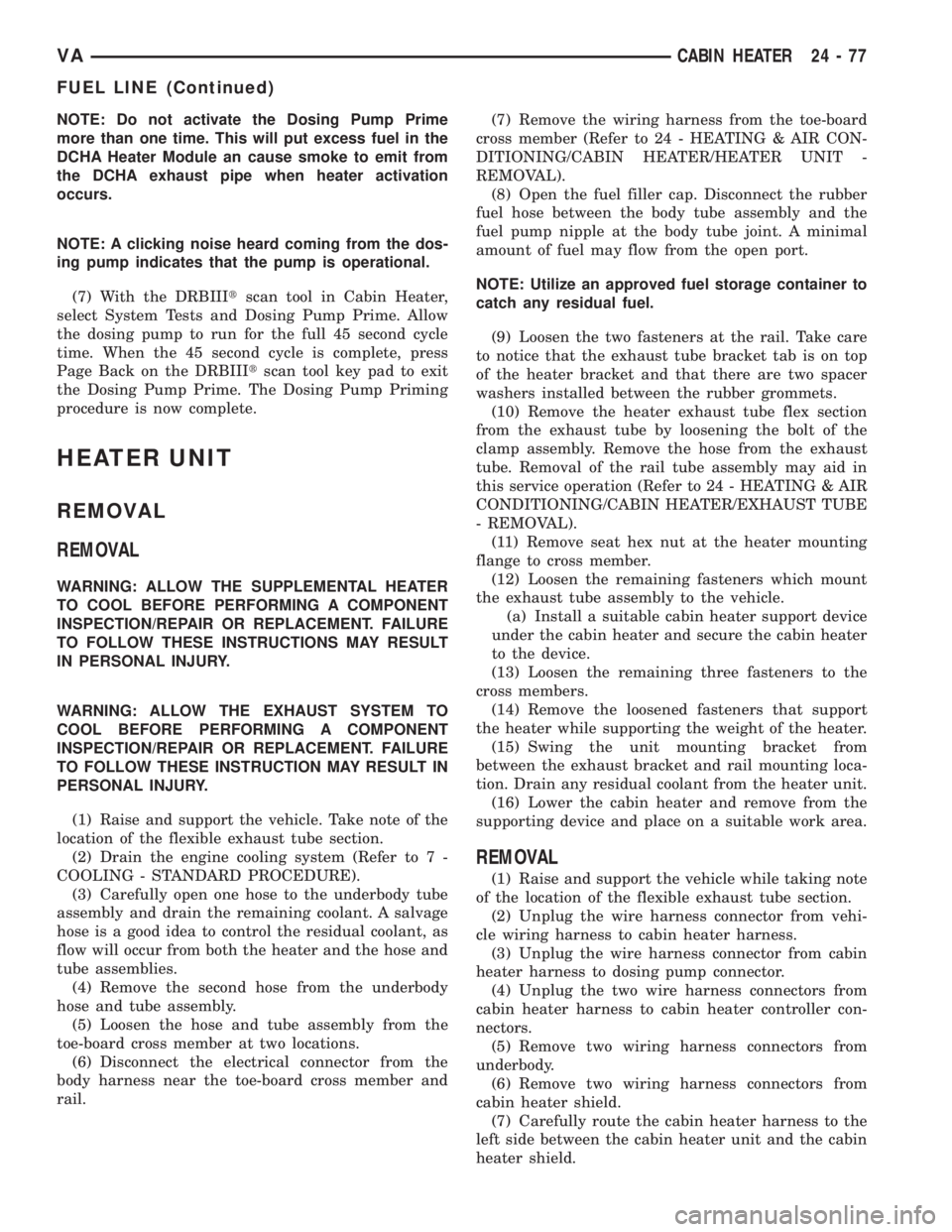
NOTE: Do not activate the Dosing Pump Prime
more than one time. This will put excess fuel in the
DCHA Heater Module an cause smoke to emit from
the DCHA exhaust pipe when heater activation
occurs.
NOTE: A clicking noise heard coming from the dos-
ing pump indicates that the pump is operational.
(7) With the DRBIIItscan tool in Cabin Heater,
select System Tests and Dosing Pump Prime. Allow
the dosing pump to run for the full 45 second cycle
time. When the 45 second cycle is complete, press
Page Back on the DRBIIItscan tool key pad to exit
the Dosing Pump Prime. The Dosing Pump Priming
procedure is now complete.
HEATER UNIT
REMOVAL
REMOVAL
WARNING: ALLOW THE SUPPLEMENTAL HEATER
TO COOL BEFORE PERFORMING A COMPONENT
INSPECTION/REPAIR OR REPLACEMENT. FAILURE
TO FOLLOW THESE INSTRUCTIONS MAY RESULT
IN PERSONAL INJURY.
WARNING: ALLOW THE EXHAUST SYSTEM TO
COOL BEFORE PERFORMING A COMPONENT
INSPECTION/REPAIR OR REPLACEMENT. FAILURE
TO FOLLOW THESE INSTRUCTION MAY RESULT IN
PERSONAL INJURY.
(1) Raise and support the vehicle. Take note of the
location of the flexible exhaust tube section.
(2) Drain the engine cooling system (Refer to 7 -
COOLING - STANDARD PROCEDURE).
(3) Carefully open one hose to the underbody tube
assembly and drain the remaining coolant. A salvage
hose is a good idea to control the residual coolant, as
flow will occur from both the heater and the hose and
tube assemblies.
(4) Remove the second hose from the underbody
hose and tube assembly.
(5) Loosen the hose and tube assembly from the
toe-board cross member at two locations.
(6) Disconnect the electrical connector from the
body harness near the toe-board cross member and
rail.(7) Remove the wiring harness from the toe-board
cross member (Refer to 24 - HEATING & AIR CON-
DITIONING/CABIN HEATER/HEATER UNIT -
REMOVAL).
(8) Open the fuel filler cap. Disconnect the rubber
fuel hose between the body tube assembly and the
fuel pump nipple at the body tube joint. A minimal
amount of fuel may flow from the open port.
NOTE: Utilize an approved fuel storage container to
catch any residual fuel.
(9) Loosen the two fasteners at the rail. Take care
to notice that the exhaust tube bracket tab is on top
of the heater bracket and that there are two spacer
washers installed between the rubber grommets.
(10) Remove the heater exhaust tube flex section
from the exhaust tube by loosening the bolt of the
clamp assembly. Remove the hose from the exhaust
tube. Removal of the rail tube assembly may aid in
this service operation (Refer to 24 - HEATING & AIR
CONDITIONING/CABIN HEATER/EXHAUST TUBE
- REMOVAL).
(11) Remove seat hex nut at the heater mounting
flange to cross member.
(12) Loosen the remaining fasteners which mount
the exhaust tube assembly to the vehicle.
(a) Install a suitable cabin heater support device
under the cabin heater and secure the cabin heater
to the device.
(13) Loosen the remaining three fasteners to the
cross members.
(14) Remove the loosened fasteners that support
the heater while supporting the weight of the heater.
(15) Swing the unit mounting bracket from
between the exhaust bracket and rail mounting loca-
tion. Drain any residual coolant from the heater unit.
(16) Lower the cabin heater and remove from the
supporting device and place on a suitable work area.
REMOVAL
(1) Raise and support the vehicle while taking note
of the location of the flexible exhaust tube section.
(2) Unplug the wire harness connector from vehi-
cle wiring harness to cabin heater harness.
(3) Unplug the wire harness connector from cabin
heater harness to dosing pump connector.
(4) Unplug the two wire harness connectors from
cabin heater harness to cabin heater controller con-
nectors.
(5) Remove two wiring harness connectors from
underbody.
(6) Remove two wiring harness connectors from
cabin heater shield.
(7) Carefully route the cabin heater harness to the
left side between the cabin heater unit and the cabin
heater shield.
VACABIN HEATER 24 - 77
FUEL LINE (Continued)
Page 1206 of 1232
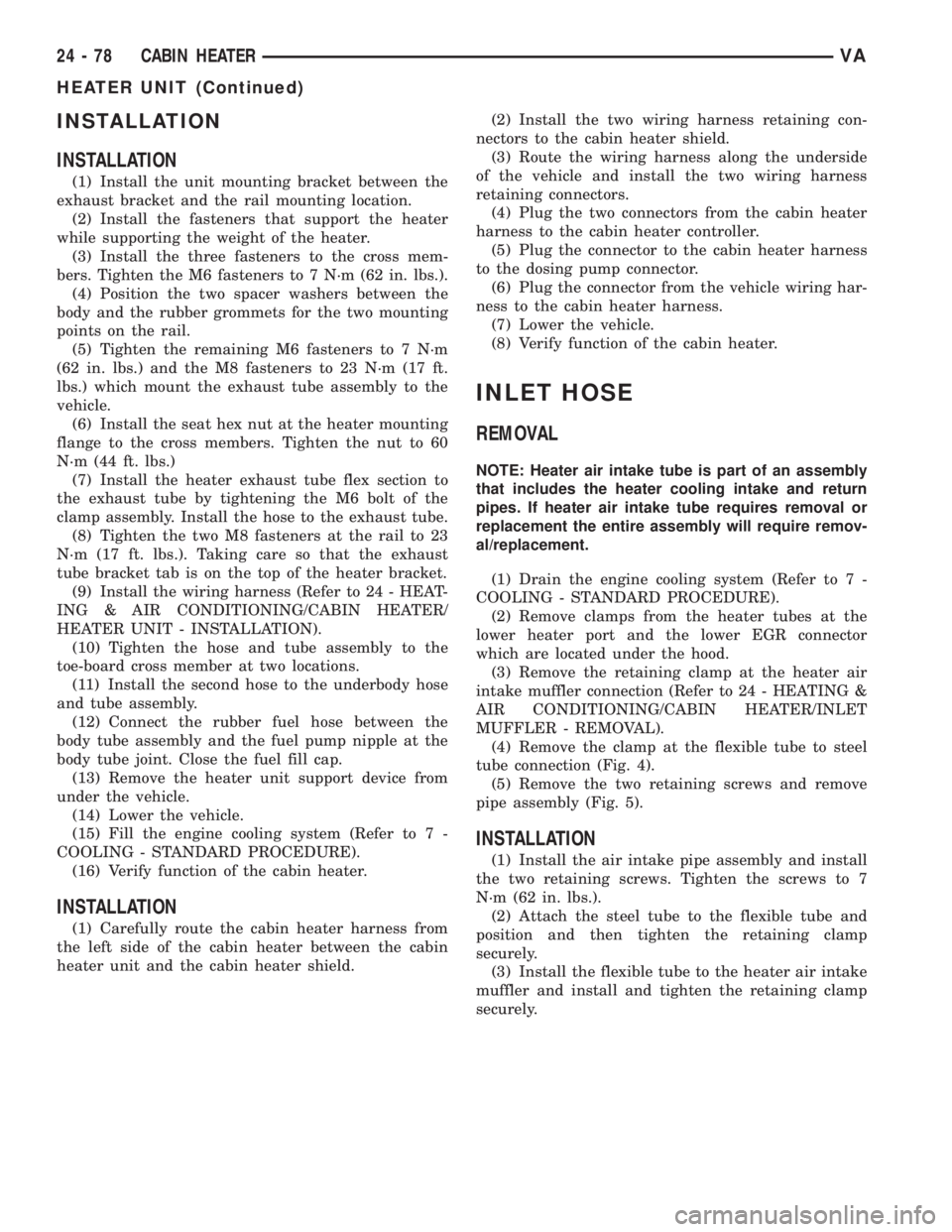
INSTALLATION
INSTALLATION
(1) Install the unit mounting bracket between the
exhaust bracket and the rail mounting location.
(2) Install the fasteners that support the heater
while supporting the weight of the heater.
(3) Install the three fasteners to the cross mem-
bers. Tighten the M6 fasteners to 7 N´m (62 in. lbs.).
(4) Position the two spacer washers between the
body and the rubber grommets for the two mounting
points on the rail.
(5) Tighten the remaining M6 fasteners to 7 N´m
(62 in. lbs.) and the M8 fasteners to 23 N´m (17 ft.
lbs.) which mount the exhaust tube assembly to the
vehicle.
(6) Install the seat hex nut at the heater mounting
flange to the cross members. Tighten the nut to 60
N´m (44 ft. lbs.)
(7) Install the heater exhaust tube flex section to
the exhaust tube by tightening the M6 bolt of the
clamp assembly. Install the hose to the exhaust tube.
(8) Tighten the two M8 fasteners at the rail to 23
N´m (17 ft. lbs.). Taking care so that the exhaust
tube bracket tab is on the top of the heater bracket.
(9) Install the wiring harness (Refer to 24 - HEAT-
ING & AIR CONDITIONING/CABIN HEATER/
HEATER UNIT - INSTALLATION).
(10) Tighten the hose and tube assembly to the
toe-board cross member at two locations.
(11) Install the second hose to the underbody hose
and tube assembly.
(12) Connect the rubber fuel hose between the
body tube assembly and the fuel pump nipple at the
body tube joint. Close the fuel fill cap.
(13) Remove the heater unit support device from
under the vehicle.
(14) Lower the vehicle.
(15) Fill the engine cooling system (Refer to 7 -
COOLING - STANDARD PROCEDURE).
(16) Verify function of the cabin heater.
INSTALLATION
(1) Carefully route the cabin heater harness from
the left side of the cabin heater between the cabin
heater unit and the cabin heater shield.(2) Install the two wiring harness retaining con-
nectors to the cabin heater shield.
(3) Route the wiring harness along the underside
of the vehicle and install the two wiring harness
retaining connectors.
(4) Plug the two connectors from the cabin heater
harness to the cabin heater controller.
(5) Plug the connector to the cabin heater harness
to the dosing pump connector.
(6) Plug the connector from the vehicle wiring har-
ness to the cabin heater harness.
(7) Lower the vehicle.
(8) Verify function of the cabin heater.
INLET HOSE
REMOVAL
NOTE: Heater air intake tube is part of an assembly
that includes the heater cooling intake and return
pipes. If heater air intake tube requires removal or
replacement the entire assembly will require remov-
al/replacement.
(1) Drain the engine cooling system (Refer to 7 -
COOLING - STANDARD PROCEDURE).
(2) Remove clamps from the heater tubes at the
lower heater port and the lower EGR connector
which are located under the hood.
(3) Remove the retaining clamp at the heater air
intake muffler connection (Refer to 24 - HEATING &
AIR CONDITIONING/CABIN HEATER/INLET
MUFFLER - REMOVAL).
(4) Remove the clamp at the flexible tube to steel
tube connection (Fig. 4).
(5) Remove the two retaining screws and remove
pipe assembly (Fig. 5).
INSTALLATION
(1) Install the air intake pipe assembly and install
the two retaining screws. Tighten the screws to 7
N´m (62 in. lbs.).
(2) Attach the steel tube to the flexible tube and
position and then tighten the retaining clamp
securely.
(3) Install the flexible tube to the heater air intake
muffler and install and tighten the retaining clamp
securely.
24 - 78 CABIN HEATERVA
HEATER UNIT (Continued)